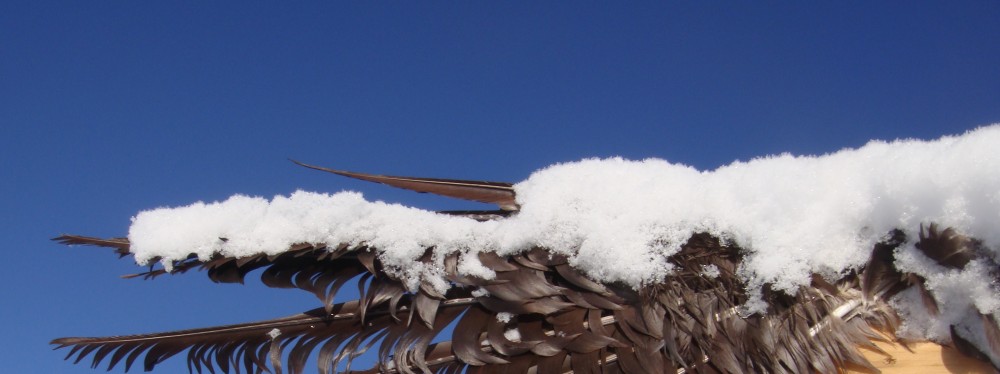 Is why you do it. It’s that simple.
Is why you do it. It’s that simple.
Last day of Song School talking with Beth Desombre. Sylph like, her voice is as delicate and precise as her guitar fingering. I’d heard her play the night before and realized that I had no memory of the song nor what it had even sounded like. But what I did recall was the shadow of the feeling, that it was gentle and honest, as if she might be the sort of person you would want to turn toward when the airplane encounters turbulence and feel grateful to be embraced by her presence.
That’s kind of what the Planet Bluegrass Song School is all about. Not about being great or even good (although there’s plenty of that), but about finding that voice that is uniquely yours and giving expression to it.
These are people who are old and retired, or middled aged and struggling to make their way through day jobs, or some so young that they don’t know yet what a day job is. But what they have in common is a compulsion to give voice to something inside them. Sometimes it’s highly polished, or whimsical, or rough and unformed, but in all cases it remains unique to each person. That’s an Ali Handall Song. Or that one there can be none other than Will Pfrang. They’re trying to perfect their written and sung voices so they most accurately express that thing within.
We’re all humans. And we’re all uneven. But once you can accept that and get beyond the judging, things get interesting. Lots of great performers, all small. Most don’t have youtube hit counts over a hundred, but that’s hardly a measure of what they pulled off on stage a last week.
Each night on stage we were treated to the rare gift of watching a human being come into his or her own. It’s that moment when you’re not paying attention and suddenly you can’t help but notice that up front something incredible is unfolding. And like the mariner fixing you with his glittering eye, you have no choice but to listen.
A round up of just a few that I remember:
Rhonda Mouser: Rhonda is maybe the reason why you go to Alamosa. Most of you will never in your lives have a chance to hear her sing Cecile. It’s not on Youtube. She has tried to record it but it just comes out flat. But what happened a few nights ago was nothing short of electric. By her own admission, she’s a performer and not a studio musician. Which perhaps is all the better. If you want Rhonda Mouser you have to find her. And what you may get will start out naive and unadorned in a Jonathan Richman sort of way, and then it veers left into the darkness of minor chords and swoops into elegiac longing, and then, if you’re lucky, it begins to soar. Try Feel the Ground or No Rain from Live at Milagros.
Will Pfrang: My daughter and I walked into town for a cup of coffee and ran into this tow head kid walking in the opposite direction. One hour and 31 minutes later we were heading back and crossed paths with the same kid in the exact same spot. And that simple coincidence of geography might speak to who he is. My daughter wondered if he was actually Mother Theresa. He’s finishing high school in Port Washington, Wisconsin and trying to figure out what he wants to do. Who knows. But as for who he is? His self seems to float almost immaterially on stage, trusting the world as might an innocent and exuding something: love, grace, gratitude – who knows what, you just know that you want to be around it.
Liza Beth Oliveto. In her role as the other half of Ten Dollar Pony, she lends a drop of nitro to the music. As for her own songs, she still struggles with her identity as a songwriter. When in life is it too late? And what if it never is? And how do you know? I sat under a tent and listened to her play Beth DeSombre’s guitar. In that moment I could only wish that more people were present. Look for her and her songwriting partner in Carson City or Reno.
Christine Lodder. Picture this 17 year old girl still emergent, leaning over the keyboard and doing what she could to keep her body from twisting into a pretzel as she released herself and bent into the song. She’ll be leaving Salt Lake City this autumn for the Berklee School of Music.
Bethel Steele. A tough name to fill, but that night on stage Bethel’s person managed to do it. Again out of Massachussetts, you sense this woman wouldn’t hesitate to protect you from the schoolyard bullies. And she probably could out sing most of them to boot. Try Whiskey.
Bella Betts: Boulder may one day claim her as their own. Just a notch above her twelfth birthday, she’s been playing mandolin since she was six and only recently began writing her own songs. She strikes you as a permanent resident in the idylls and energy of youth. Not one to walk, she’s more prone to skip and run as she bounds around about the Planet Bluegrass Ranch. And she’s one of those rare kids who also feels like she’s a hundred. Listen to her if you’ve perhaps forgotten what it means to be thoughtful, or curious and young.
Bella Hudson: Mazie and I first saw her playing on a street corner in Telluride about three years ago. Just turned 13, she knows how to own a stage and is able to sing a handful of years beyond that. She’s recording her first album this fall in Nashville.


























